#the gallic celts
Explore tagged Tumblr posts
Text



Today's Celtic character of the day is Impedimenta from Asterix who is Gaul (ancient Celt). She is from a fictional village in northwest Armorica.
44 notes
·
View notes
Text

The Gaul - Gallic Warrior
#art#illustration#design#digital art#drawing#drawdrawdraw#character design#sword#rpg#dnd#gaul#gallic#warrior#celt#armor#chainmail#swords#helmet#artist#fantasy art#history#historical
65 notes
·
View notes
Text
Vercingetorix

Nothing's ever over
There is no closure
No fulfillment, no relief
You'll have to trust me on this
There is no closure
Nothing's ever over
There's no end to history
You'll see
Rome band, "Alesia"
#lineart#vercingetorix#gaul#galatians#ancient warrior#alesia#gallic chieftain#celtic#celtic warrior#ancient celts#digital art#my art
5 notes
·
View notes
Text
The Gauls: Ancient Celtic Peoples of Europe
The Gauls were a collection of Celtic tribes who lived in what is now France, Belgium, Luxembourg, Switzerland, and parts of Italy, the Netherlands, and Germany during the Iron Age. Known for their fierce independence, rich culture. And resistence to Roman conquest, the Gauls played a vital role in shaping the history of ancient Europe.
Who Were the Gauls?
The term "Gaul" comes from the Latin Gallia, the Roman name for the region the Gauls inhabited. They were not a single unified nation but a confederation of tribes, each with its own customs, leaders, and territories. Despite their diversity, they shared Celtic language, art, religion, and social structures, linking them culturally to other Celtic peoples across Europe.
The Gauls were primarily agrarian, living in hillforts and villages, practicing farming, herding, and metalworking. They were also skilled in trade, exchanging goods like salt, grain, textiles, and metalwork with neighboring cultures, including the Greeks and Romans.
Society and Culture
Gaulish society wad tribal and hierarchical:
At the top were nobles and warrior elites who commanded respect through leadership and bravery in battle.
Druids held spiritual, legal, and intellectual authority, acting as priests, judges, and keepers of oral tradition.
The majority of the population were farmers, craftsmen, and traders who sustained the tribes' economy.
Gauls were renowned for their artistry, particularly in intricate metalwork, jewelry, and weaponry. Their art featured swirling geometric patterns, animal motifs, and symbolic designs that reflected their spiritual beliefs.
Religion and Beliefs
Like other Celtic peoples, the Gauls practiced polytheism, worshipping numerous gods connected to nature, warfare, fertility, and the Otherworld. Sacred groves, rivers, springs, and hilltops were their primary religious sites.
Some prominent Gaulish deities included:
Cernunnos, the horned god of nature and animals.
Epona, the goddess of horses and fertility.
Taranis, the thunder god.
Sucellus, associated with agriculture and abundance.
Druids oversaw rituals, sacrifices, and festivals that honored these deities and the cycles of nature.
Warriors and Warfare
The Gauls were feared warriors in the ancient world. They fought with long sword, spears, and shields, often wearing brightly colored clothing and trocs (neck rings) as symbols of status. They also had a reputation for charging into battle fearlessly, sometimes without armor.
In 390 BCE, a group of Gauls famously sacked Rome, leaving a deep impression on Roman memory. Over the following centuries, they repeatedly clashed with Roman forces.
Roman Conquest of Gaul
The most famous confrontation between the Gauls and Rome came during Julius Caesar's Gallic Wars (58—50 BCE). Despite fierce resistance led by Vercingetorix, a chieftain who united several tribes against Rome, the Gauls were ultimately defeated.
After their conquest, Gaul became a Roman province, heavily influenced by Roman culture. Many Gaulish gods were merged with Roman ones, and Latin replaced the Gaulish language. However, some Celtic traditions survived beneath the surface.
Legacy of the Gauls
Even after their assimilation into the Roman Empire, the legacy of the Gauls endured. Elements of their language, customs, and mythology influenced later French culture. Modern France still carries the memory of its Celtic past—the name "France" itself stems from the later Frankish period, but "Gaul" remains a poetic and historical name for the region.
Today, the Gauls are remembered as a symbol of resistance, freedom, and cultural identity, their stories immortalized in history, archaeology, and even popular culture (like the famous Asterix comics).
Conclusion
The Gauls were more than just warriors who fought Rome—they were a vibrant Celtic people with a rich culture deeply tied to nature, spirituality, and craftsmanship. Through much of their world was transformed by Roman conquest, their spirit remains woven into the history of Europe, a reminder of the diverse cultures that flourished before the rise of empires.
#circleofcrows.txt#gauls#ancient gauls#gallia#celtic peoples#ancient celts#celtic history#iron age europe#ancient europe#european history#druids#celtic warriors#vercingetorix#julius caesar#gallic wars#celtic mythology#pagan europe#ancient paganism#nature worship#celtic art#celtic culture#tribal societies#roman history#pre roman europe#archaeology#mythologyblr#historyblr
2 notes
·
View notes
Text
no hate to Vercingetorix (love u bestie), but if i were at the Battle of Alesia 52bc, i would simply ask Caesar to Chill™
#history#shitpost#vercingetorix#Caesar#julius caesar#roman empire#Gallic#ancient celts#celtic rage#celtic#celts#battle#battle of alesia#52bc#this is not to be taken seriously#sca#scadian#calontir#ancient history
6 notes
·
View notes
Text
(x)
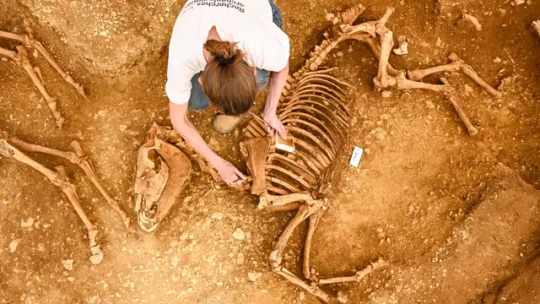
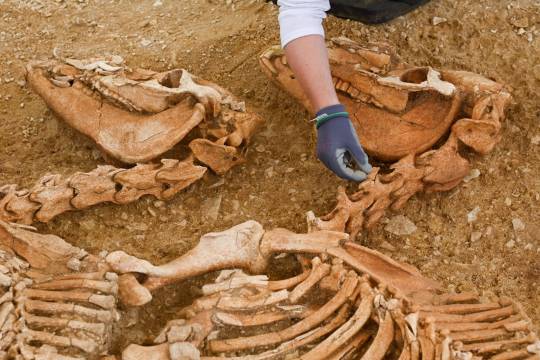
Archaeologists Uncover ‘Astonishing’ Remains of Horses Buried 2,000-Years-Ago
Archaeologists in France have uncovered nine “astonishing” graves containing the skeletons of 28 horses that were buried about 2,000 years ago, though their precise cause of death remains a mystery.
Discovered in Villedieu-sur-Indre, a commune in central France, two of the graves have been fully excavated so far, the French National Institute for Preventive Archaeological Research (INRAP) said in a statement.
The horses have been radiocarbon-dated back to somewhere between 100 BC to 100 AD.
Archaeologists found 10 complete horse skeletons in one pit and two in the other, all carefully placed in the same manner lying on their right flank with their heads to the south.
All these horses were buried at the same time shortly after their deaths, archaeologists said after observing the position of the skeletons and the connections between the bones.
Another grave is situated between these two pits but it contains two medium-sized dogs, both lying on their left side with their heads facing west.

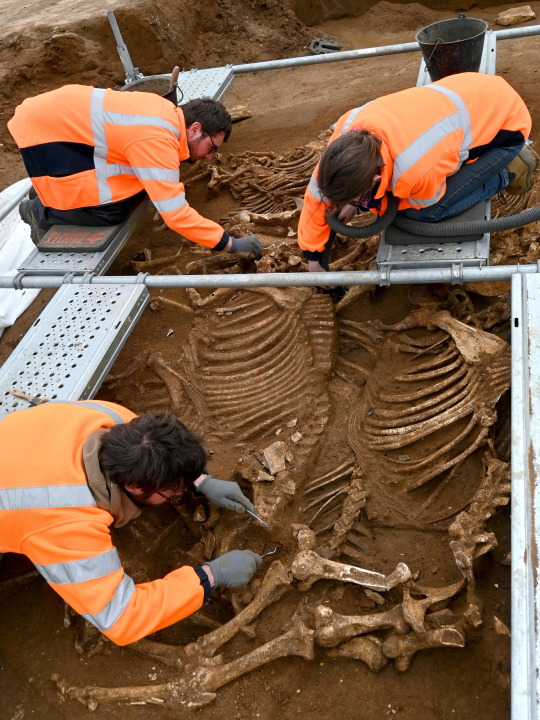
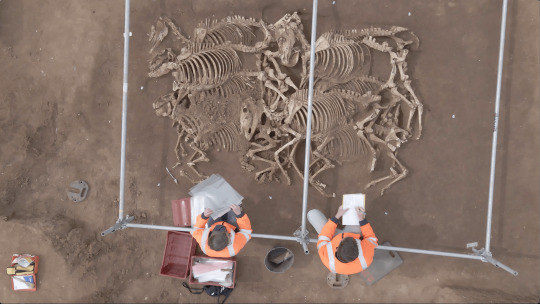
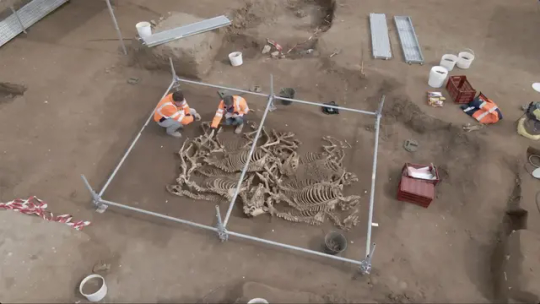
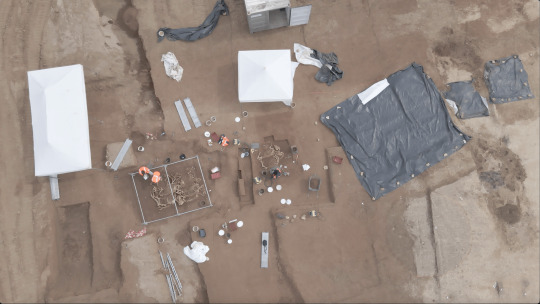
Archaeologists have yet to fully excavate the remaining graves but have already identified a total of 28 horses from the skulls and coxal bones that appear on the surface.
Killed in battle, or ritual sacrifice?
However, the horses’ precise cause of death still remains unclear.
Archaeologists have ruled out an epidemic since there are no foals or mares in these graves; all the skeletons are fully-grown stallions aged over four years old. That leaves, archaeologists said, the possibilities that these horses were either killed in battle or as part of a ritual sacrifice.
When these horses died about 2,000 years ago, there was a fortified Celtic settlement known as an oppidum just a few hundred meters away and this location mirrors that of two other similar horse burial sites that archaeologists had previously uncovered in the same region.
Due to this location, they have hypothesized that the horses’ deaths at the sites could be connected to the battles of the Gallic Wars in which Julius Caesar conquered Gaul between 58 - 50 BC.
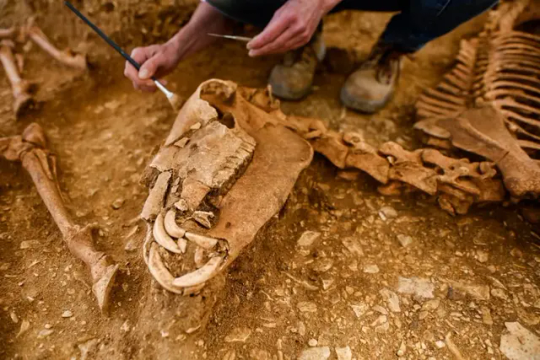
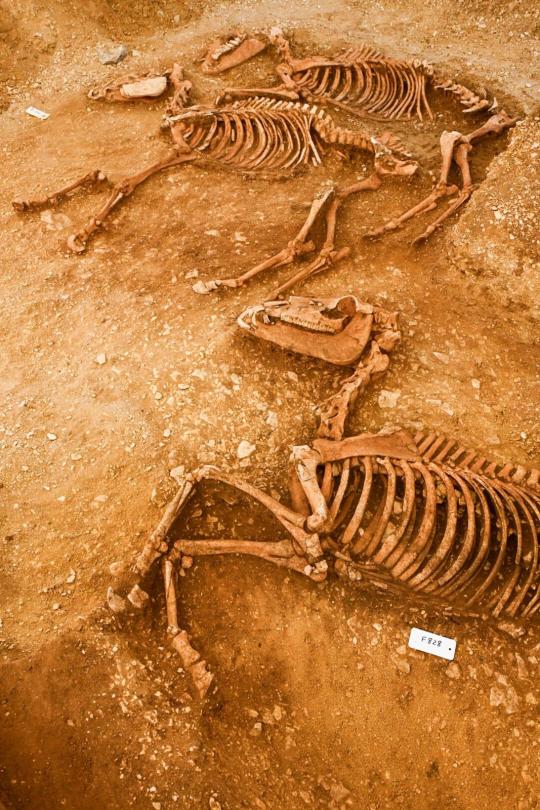
There may be another explanation, however: ritual sacrifice.
“The hypothesis that these animals were sacrificed as part of a complex ritual, of which only a few scraps remain, must also be considered,” the INRAP statement said.
If these horses were indeed buried as part of a ritual rather than killed in battle, the sheer number shows the “importance and extent of the sacrifice,” the statement added.
Other finds at the site, which sits on the slope of a valley, include buildings, pits, ditches and a road that archaeologists dated to the late 5th and early 6th centuries.
By Issy Ronald.

#history#classics#military history#archaeology#animals#burials#gallic wars#ancient rome#celts#gaul#roman gaul#france#horses
1K notes
·
View notes
Text
"Conquest" - réédition de la version anglaise
Ce 14 janvier 2024 ressortira une nouvelle édition de “La Guerre des Gaules” dans le monde anglo-saxon, sous le titre de “Conquest” aux éditions Black Panel Press
youtube
View On WordPress
0 notes
Text
If I had a penny for every time a Belmont got startled by a fox...




So, @aquilaofarkham pointed this out on BlueSky, and is totally right about it (they made the screenshots to, thanks for allowing me to use them!). Why I clocked this scene in Nocturne as well - I actually did not draw the comparison to the Trevor season 3 scene. But yes, that is indeed...
If I got a penny for every time a Belmont got startled by a fox, I would have two pennies, which is not a lot, but it is weird it happened twice.
And you know what that means, right?
THEORY TIME!!!
As some people might know: Since season 1 of Nocturne was out, I am very very certain of one thing. And that thing is, that the Belmont bloodline also goes back to a god.
In S1 of Nocturne when Annette talks about her own divine bloodline, she says a lot of people do have a divine ancestor, but the knowledge got lost. And to me this instantly read as: "Actually, by the way, the Belmonts totally have a divine ancestor as well!"
And I have been riddling since then, who it could be.
So, what if the fox is a representation of that ancestor?
Yes. This does mean I get to talk mythology again.
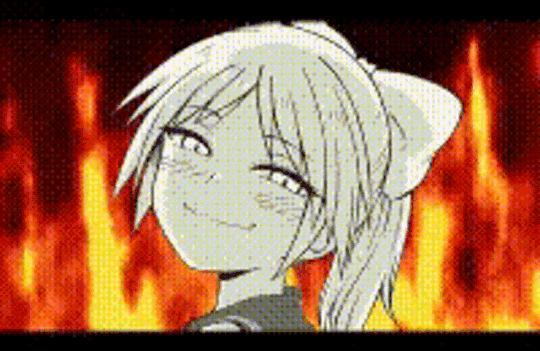
So, foxes. In early European folklore the fox is basically equivalent to coyote in North American folklore. Especially in Germany and France Reynard or Reinecken shows up a lot as a trickster spirit in the form of a fox. While there are some theories on Reynard somewhat going back to an actual deity, we kinda don't know about that for sure, because we have absolutely no textual evidence for it, and it mostly goes back to the fact that throughout the area in early medieval times the depiction of Reynard as a trickster is very very consistent - and also lines up with more eastern depictions of fox adjacant deities. Since we know that those are connected through Indo-European culture group it is not so weird to assume that there might have been a fox trickster deity, though if there was, we do not know their name.
But the good news is: The Belmonts are French in origin, and we do know from Trevor that they had contact to indigenous European people (aka the Celts). So, the highest likelihood for a divine ancestor is definitely a Celtic god or goddess.
Now, if we talk about Celtic deities we obviously run into the problem: Outside the Gaelic culture we know Jack Shit. Because fuck the fucking Romans and fuck the Christians even more, who very thoroughly erased most stuff about those religions. My anthropology heart does not spend three hours a day crying about this fact at all!!!!
Of course, we know the Celtic cultures were related, so there is a high likelihood that at least some of the deities from the Gaelic culture will also show up in the Gaulic culture, but we do not know for certain.
Which on the bright side also means, that my guess is about as good as whatever the writers might come up with. Hooray!
So, my first guess is Adsagsona. A goddess about whom we know exactly nothing. We know she was a goddess of magic, who was invoked in spells. And we have the suspicion she was maybe linked to foxes. Maybe. Because the thing is, we do have one written evidence of her being invoked, and some artifacts from the same area she was invoked in that might be related to her and the practice of magic. Which is not a lot. Cool bit about that, of course: It would totally give a writer freedom to make up whatever about this.
Next guess would be Arduinna. She was a forest goddess who got merged with Diana when the Romans colonized what is France today. She definitely got depicted a lot with forest animals, and definitely also was connected to the hunt (which works well with the Belmonts), though the preferred animal for her to be paired with was either the deer or the boar. Which, I would guess, makes sense, because people hunted those more for food than they would hunt foxes.
A bit more vague would be the god Cunomaglus. Because he is British, not Gallic, though definitely he is a hunting god, and while his main animal was the dog, he definitely got also depicted with foxes. No doubt about that bit. xD
Next up would be a probably related god to Cunomaglus: Nodens. Again, British. Again, hunting. Again, the main animal are gods. I would not know about him being depicted with foxes, but given he has a lot of overlap with Cunomaglus I would also not be surprised. Bonus points, because I know there is fandom-overlap between GDT's Hellboy movies and Castlevania: Nuada is based on the Irish equivalent to Nodens, and draws a lot of influence from the Brittanic god.
If we go a bit more wild, we could also make a guess for Ceres, though that one would be a bit weird. Ceres is of course a Roman Goddess, but Romans were also in France forever, so it is not impossible. Ceres is heavily associated with foxes, though mainly in the sense that foxes are sacrificed for her. But there is a fox association.
There is also with the Roman gods a very loose association with both Dionysus and Diana. But Diana usually gets depicted with dogs and stags, and for Dionysus there is exactly one myth linking him to foxes. So... Eh.
Lastly... I will just leave here that Diana's Slavic equivalent, Devana, actually gets depicted as a fox more than once. But Slavic culture is kinda on the other end of Europe. So it is possible, but also... Eh. It is a far bit away. But then again, the Belmonts lived in today's Romania for a long while, so it is not impossible, I guess.
And that's it. For today at least.
But I wanted to get this off my chest.
#castlevania#castlevania netflix#castlevania nocturne#castlevania meta#fan theory#speculation#celtic mythology#roman mythology#slavic mythology#european history#trevor belmont#juste belmont
105 notes
·
View notes
Photo
It's that time of the year again.

tmw ides of march comes around and you listen to eluveitie
@coasttocoastlikebutteredtoast
35 notes
·
View notes
Text
The gods of Gaul: Introduction, or why it is so hard to find anything
As I announced, I open today a series of post covering what some can call the "Gaulish mythology": the gods and deities of Ancient Gaul. (Personal decision, I will try avoiding using the English adjective "Gaulish" because... I just do not like it. It sounds wrong. In French we have the adjectif "Gaulois" but "Gaulish"... sounds like ghoulish or garrish, no thank you. I'll use "of Gaul", much more poetic)
[EDIT: I have just found out one can use "Gallic" as a legitimate adjective in English and I am so happy because I much prefer this word to "Gaulish", so I'll be using Gallic from now on!]
If you are French, you are bound to have heard of them one way or another. Sure, we got the Greek and Roman gods coming from the South and covering up the land in temples and statues ; and sure we had some Germanic deities walking over the rivers and mountains from the North-East to leave holiday traditions and folk-beliefs... But the oldest gods of France, the true Antiquity of France, was Gaul. And then the Roman Gaul, and that's already where the problems start.
The mythology of Gaul is one of the various branches of the wide group known as Celtic mythology or Celtic gods. When it comes to Celtic deities, the most famous are those of the British Isles, due to being much more preserved (though heavily Christianized) - the gods of Ireland and the Welsh gods are typically the gods every know about when talking about Celtic deities. But there were Celts on the mainland, continental Celts - and Gaul was one of the most important group of continental Celts. So were their gods.
Then... why does nobody know anything about them?
This is what this introduction is about: how hard it actually is to reconstruct the religion of Gaul and understand its gods. Heck we can't ACTUALLY speak of a Gaulish mythology because... we have no myth! We have not preserved any full myth or complete legend from Ancient Gaul. The pantheon of Gaul is the Celtic pantheon we probably know the least about...
Why? A few reasons.
Reason number one, and the most important: We have no record of what the Gauls believed. Or almost none. Because the people of Gaul did not write their religion.
This is the biggest obstacle in the research for the gods of Gaul. It was known that the art of writing was, in the society of Gaul, an elite art that was not for the common folks and used only for very important occasions. The druids were the ones who knew how to read and write, and they kept this prerogative - it was something the upper-class (nobility, rulers) could know, but not always. Writing was considered something powerful, sacred and magical not to be used recklessly or carelessly. As a result, the culture of Gaul was a heavily oral one, and their religion and myths were preserved in an oral fashion. Resulting in a great lack of written sources comng directly from the Gallic tribes... We do have written and engraved fragments, but they are pieces of a puzzle we need to reconstruct. We have votive offerings with prayers and demands inscribed on it - and while they can give us the names of some deities, they don't explain much about them. We have sculptures and visual representations of the deities on pillars and cups and jewels and cauldrons - but they are just visuals and symbols without names. We have calendars - but again, these are just fragments. We have names and images, and we need to make sense out of it all.
To try to find the explanations behind these fragments, comparisons to other Celtic religions and mythologies are of course needed - since they are all branches of a same tree. The same way Germanic mythology can be understood by looking at the Norse one, the same way Etruscan, Greek and Roman mythologies answer each other, the mythology and religion of Gaul has echoes with the Celtic deities of the Isles (though staying quite different from each other). The other comparison needed to put things back into context is reason number 2...
Reason number two: The Romans were there.
Everybody knows that the death of Ancient Gaul was the Roman Empire. Every French student learns the date of Alesia, the battle that symbolized the Roman victory over the Gallic forces. Gaul was conquered by the Romans and became one of the most famous and important provinces of the Roman Empire: it was the Gallo-Roman era.
The Romans were FASCINATED by Gaul. Really. They couldn't stop writing about them, in either admiration or hate. As a result, since we lack direct Gallic sources, most of what we know about Ancient Gaul comes from the Romans. And you can guess why it is a problem. Some records of their religion were written in hatred - after all, they were the barbarian ennemies that Romans were fighting against and needed to dominate. As such, they contain several elements that can be put in doubt (notably numerous references to brutal and violent human sacrifices - real depictions of blood-cults, or exaggeratons and inventions to depict the gods of Gaul as demonic monstrosities?) But even the positive and admirative, or neutral, records are biased because Romans kept comparing the religion of the Gauls to their own, and using the names of Roman deities to designate the gods of Gaul...
Leading to the other big problem when studying the gods of Gaul: the Roman syncretism. The Gallo-Roman era saw a boom in the depictions and representations of the Gallic gods... But in their syncretized form, fused with and assimilated to the Roman gods. As such we have lots of representations and descriptions of the "Jupiter of Gaul", of the "Mercury of Gaul", of the "Gallic Mars" or "Gallic Minerva". But it is extremely hard to identify what was imported Roman elements, what was a pure Gallic element under a Roman name, and what was born of the fusion of Gallic and Roman traditions...
Finally, reason number three: Gaul itself had a very complicated approach to its own gods.
We know there are "pan-gallic" gods, as in gods that were respected and honored by ALL the people of Gaul, forming the cohesion of the nation. But... Gaul wasn't actually a nation. It was very much like the many city-states of Greece: Ancient Gaul was unified by common traditions, a common society, a common religion and a common language... But Gaul was a tribal area divided into tribes, clans and villages, each with their own variations on the laws, each with their own customs and each with their own spin on religion. As a result, while there are a handful of "great gods" common to all the communities of Gaul, there are hundreds and hundreds of local gods that only existed in a specific area or around a specific town ; and given there were also many local twists and spins on the "great gods", it becomes extremely hard to know which divine name is a local deity, a great-common god, a local variation on a deity, or just a common nickname shared by different deities... If you find a local god, it can be indeed a local, unique deity ; or it can be an alternate identity of a shared divine archetype ; or it can be a god we know elsewhere but that goes by a different name here.
To tell you how fragmented Gaul was: Gaul was never a unified nation with one king or ruler. The greatest and largest division you can make identifies three Gauls. Cisalpine Gaul, the Gaul located in Northern Italy, conquered by the Romans in the second century BCE, and thus known as "the Gaul in toga" for being the most Roman of the three. Then there was the "Gaul in breeches" (la Gaule en braies), which borders the Mediterranean sea, spanning between the Alps and the Pyrenean mountains, and which was conquered in the 117 BCE (becoming the province of Narbonne). And finally the "Hairy Gaul", which stayed an independant territory until Cesar conquered it. And the Hairy Gaul itself was divided into three great areas each very different from each other: the Aquitaine Gaul, located south of the Garonne ; the Celtic Gaul located between the Garonne and the Marne (became the Gaul of Lyon after the Roman conquest) ; and finally the Belgian Gaul, located between the Marne and the Rhine. And this all is the largest division you can make, not counting all the smaller clans and tribes in which each area was divided. And all offering just as many local gods or local facets of a god...
And if it wasn't hard enough: given all the sculptures and visuals depictions of the gods of Gaul are very "late" in the context of the history of Gaul... It seems that the gods of Gaul were originally "abstract" or at least not depicted in any concrete form, and that it was only in a late development, shortly before the Roman invasions, that people of Gaul decided to offer engravings and statues to their gods, alternating between humanoid and animal forms.
All of this put together explains why the gods of Gaul are so mysterious today.
200 notes
·
View notes
Text
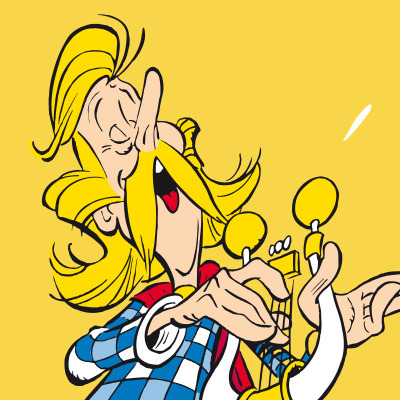

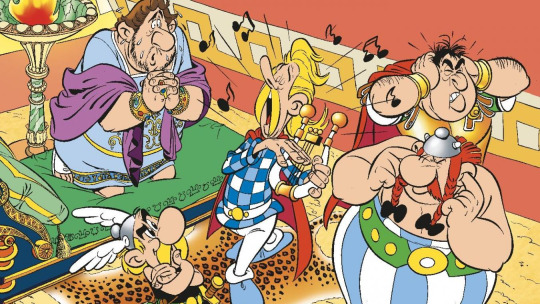
Today's Celtic character of the day is Cacofonix (Assurancetourix en Français) from Asterix who is Gaul (ancient Celt). He is from a fictional village in northwest Armorica.
#celtic character of the day#cacofonix#assurancetourix#asterix#asterix comics#gallic#gaul#ancient celts
21 notes
·
View notes
Photo
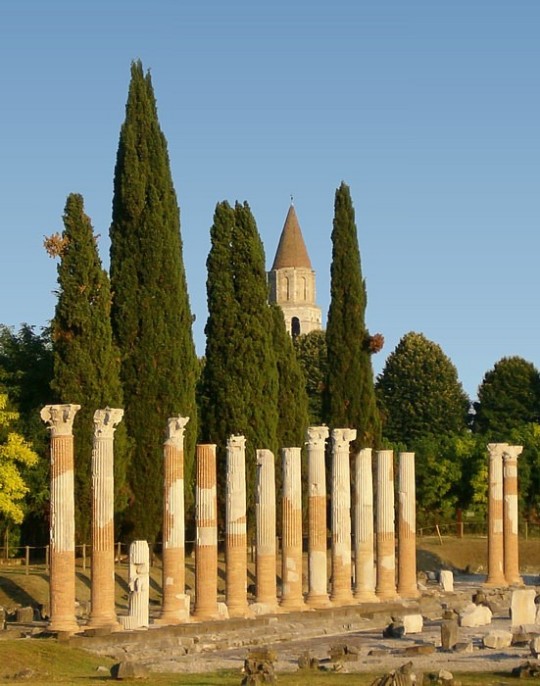
Aquileia
The ancient city of Aquileia was situated near the head of the Adriatic Sea west of the Roman province of Illyria. The strategic location of the city served a crucial role in the expansion of the Roman Republic by serving as a buffer against possible invasions from the Germanic tribes to the north. As a colony with major harbor facilities, Aquileia allowed the Romans to exploit both the neighboring gold mines as well as the region's own rich amber.
To the north of the colony was the independent territory of Noricum. It would become a Roman province in 16 BCE under Roman emperor Augustus (27 BCE to 14 CE). Although Noricum controlled a few minor routes over the Alps, its location south of the Danube and abundant iron and gold reserves were far more valuable to the Republic, allowing trade to emerge between Noricum and northeastern Italy, namely Aquileia. As a buffer and center of trade, the city would eventually become one of the largest and wealthiest cities of the Roman Empire, becoming the capital of Venetia et Istria.
A Gallic Region
Lying to the north and northeast of the Italian peninsula far to the west of Aquileia lay Cisalpine and Transalpine Gaul. During the early and middle Roman Republic, the area was not considered part of Italia, which only extended to the foothills of the Apennines. Cisalpine Gaul comprised the area from the plains of the Po River to the Apennines, while Transalpine Gaul extended beyond the Alps northward. Although sources vary, Cisalpine Gaul was initially the home of the Etruscans; however, Celtic tribes from north of the Alps – the Insubres and Senones among them – gradually moved into the area, and by the end of the 4th century BCE, the Etruscans had been completely forced out – thereby enabling the Celts (Gauls) to make the occasional raid into Italian territory.
Around 390 BCE, the Celts were bold enough to push further south and sack the city of Rome. Tom Holland in his Rubicon wrote that "a barbarian horde had burst without warning across the Alps, sent a Roman army fleeing from it in panic, and swept into Rome" (234). Although sporadic raids continued into the 3rd century BCE, in 225 BCE, Rome was able to defeat the Gallic invaders at Telamon – a city located on the coast of Etruria between Rome and Pisa. Realizing the importance and potential of the region, the Romans went on a three-year campaign, capturing Mediolanum (Milan) in 223 BCE. Further attempts to move northward were foiled by the Carthaginian commander Hannibal in the Second Punic War (218-201 BCE) where many of the Celtic tribes sided with Hannibal. After his defeat, Rome continued their foray into the region, establishing colonies at Cremona and Placentia (Piacenza).
Continue reading...
44 notes
·
View notes
Text
2100 Year Old Celtic Hoard in Jersey

By Chipmunkdavis - Own work based on: Europe-Northern Cyprus.svg and Europe-Serbia.svg Own work based on: Jersey Map.svg by Ichwan Palongengi, CC BY-SA 3.0, https://commons.wikimedia.org/w/index.php?curid=13554803
The Bailiwick of Jersey is an island in the English Channel, 23 km from Cotentin Peninsula, Normandy, France. It is now a self-governing British Crown Dependency, but has been home to humans since about 12,000 BCE at the latest, with the earliest dates going back about 250,000 years ago. The island has only been separated from mainland Europe for about 6,000 years due to sea level rise caused by retreating glaciers.

Source: https://www.theguardian.com/science/2025/mar/11/mystery-iron-age-hoard-jersey-solved
In 2012, a large hoard of about 70,000 silver coins, 11 gold torques, and a collection of jewelry was found by metal detectorists. Initially, it was uncertain why the treasures were transported to a remote, unpopulated area with dangerous off-shore reefs. One theory was that the treasures were hurriedly moved out of Normandy and Brittany to keep them out of the hands of Julius Caesar's armies during the Gallic wars.
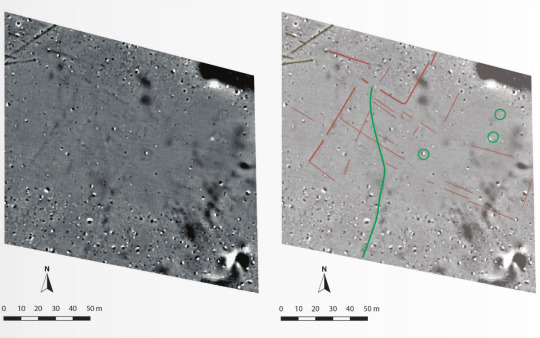
Source: https://www.wreckwatchmag.com/
More recent surveys of the area, however, showed linear anomalies for 'several tens of metres, parallel and perpendicular to each other, some with subdivisions that resemble late iron age rural Celtic settlements in northern France.' There are also anomalies that appear to be pits and postholes.
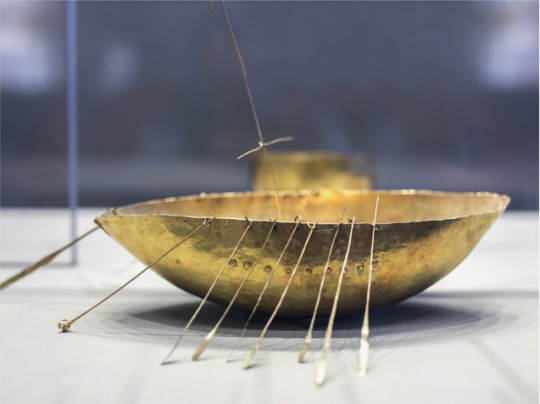
Source: https://www.wreckwatchmag.com/
One researcher, who explored more than 350 shipwrecks in 30 years, said that '[b]y the time Caesar attacked Brittany in 56 BC[E], the Celts' seaborne trade was a well-oiled machine. Practical knowledge about low and high water times, the location of the shoals, winds, weather and landing places had long been passed down from generation to generation.' This would make it safe for those sailors to traverse the span of water between Brittany or Normandy to Jersey with relative ease, especially compared to the Romans.
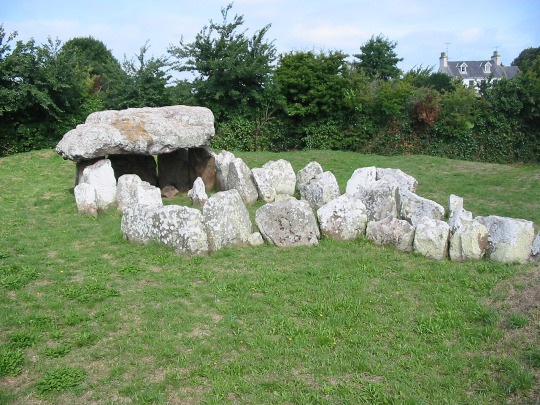
By User:Man vyi - From English Wikipedia, CC SA 1.0, https://commons.wikimedia.org/w/index.php?curid=1876748
A megalithic tomb was also found on the hill overlooking where the settlement was found, possibly marking the area as sacred to the Celtic people who lived there, linking them back to the Neolithic people who lived there.
4 notes
·
View notes
Text
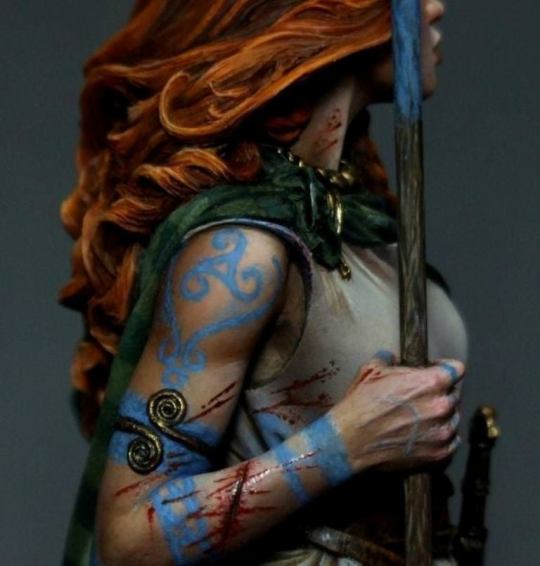
The Celts were a diverse group of ancient tribal societies that inhabited parts of Europe from the Iron Age through the Roman period and beyond. They had their own heroes figures who played significant roles in Celtic history. Here are a few notable ancient Celtic heroes:
Vercingetorix: Vercingetorix was a chieftain of the Arverni tribe in Gaul who led a coalition of Celtic tribes in a revolt against Roman conquest during Julius Caesar's time. He is considered a hero for his efforts to resist Roman domination, although he was eventually captured by Caesar.
Boudicca (Boadicea): Queen Boudicca of the Iceni tribe is both a mythological and historical figure. She is celebrated as a hero for leading a rebellion against Roman rule in Britain in the 1st century AD, standing up for the rights and dignity of her people.
Queen Medb (Maeve): Medb, the legendary queen of Connacht in Irish mythology, also has historical roots. While her mythical exploits are well-known, she may have been based on a historical queen who ruled over the Connacht region. She is sometimes celebrated as a strong and influential leader.
Ambiorix: Ambiorix was a Celtic chieftain of the Eburones tribe in what is now Belgium. He is known for leading a successful revolt against Julius Caesar's forces in 54 BC during the Gallic Wars. His cunning tactics and resistance against the Roman army have earned him a place in history as a Celtic hero.
Caratacus (Caradog): Caratacus was a British tribal leader who resisted Roman rule in Britain during the 1st century AD. He led a long campaign against Roman forces and is celebrated for his tenacity in resisting foreign occupation.
Viriathus: Viriathus was a Lusitanian leader in ancient Iberia (modern-day Portugal and Spain) who led a successful rebellion against Roman rule in the 2nd century BC. He is considered a symbol of resistance against Roman expansion in the region.
And there are more. These historical figures are celebrated as Celtic heroes for their roles in resisting foreign invaders and defending their Celtic cultures and communities during times of conflict and conquest. While their stories may have been embellished over time, they continue to be remembered for their bravery and leadership.
10 notes
·
View notes
Text
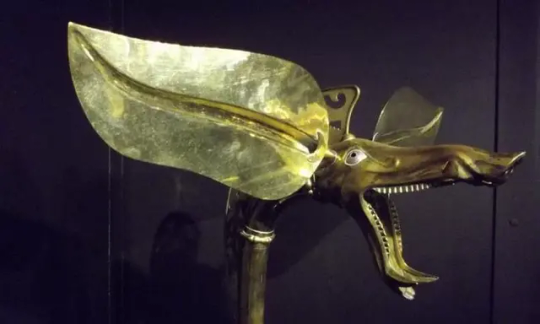

The 'Carnyx' Nightmare of the Roman Soldiers
The Carnyx was a brass musical instrument used as a psychological weapon of war by the ancient Celts between 300 BC and 200AD in western and central Europe and beyond.
The carnyx was once widespread throughout much of Europe, although only a dozen or so fragments are known to us.
It was carried by bands of Celtic mercenaries; it was present at the attack on the Greek sanctuary at Delphi in 279 BC; it defied Julius Caesar in Gaul; and it faced Claudius when he invaded Britain. They are even shown on a Buddhist sculpture in India, proof of the far-flung connections of the Iron Age world.
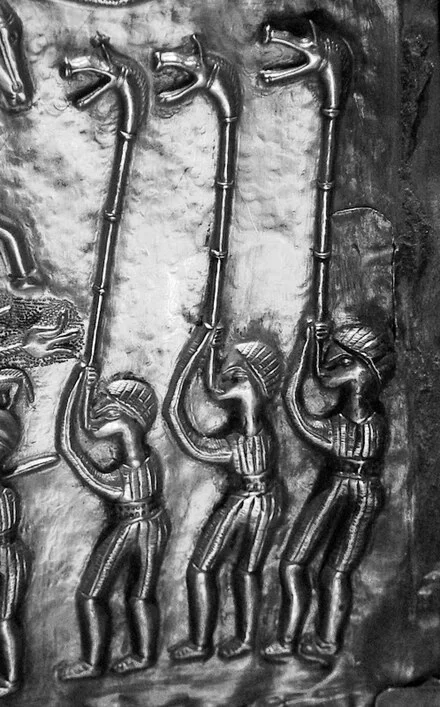
However, they were not only used by the Celts; they were also used by the Dacians in modern Romania. The term “Celtic” is a complicated one. The concept of a pan-European Celtic culture is a myth; rather, aspects of art and technology were shared across vast distances by diverse cultures. The carnyx was one example of this.
A 12-foot-long, thin bronze tube with right-angle bends on both ends made up the carnyx. The lower end ended in a mouthpiece, and the upper end flared out into a bell that was usually decorated to look like a wild boar’s had. Historians believe it had a tongue that flapped up and down, increasing the noise made by the instrument. The carnyx was played upright so that the boar’s head bell protruded well above the warriors’ heads. Its primary goal was to create more noise and confusion on the battlefield.
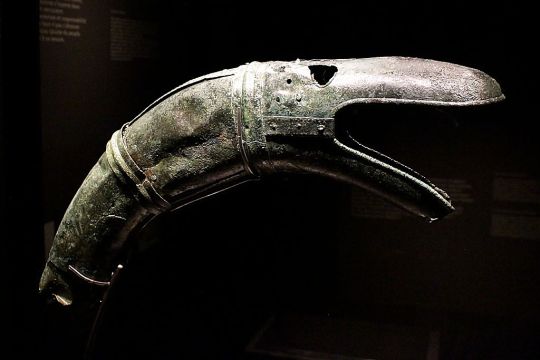
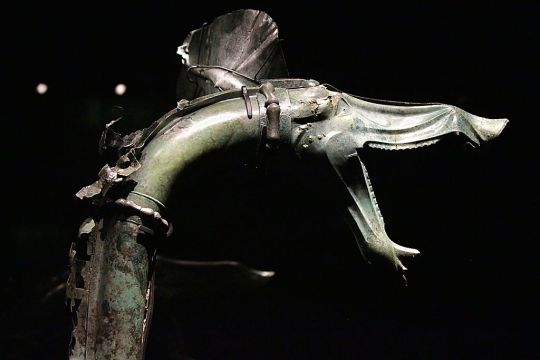
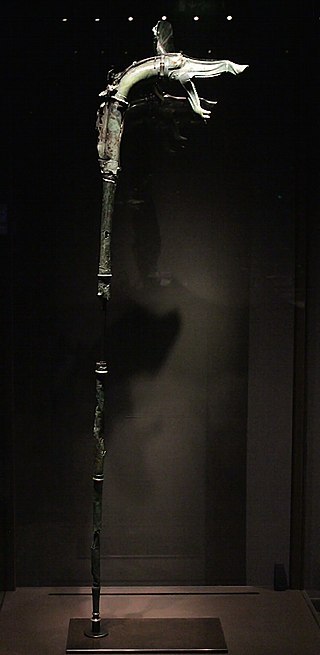
The Greek historian Polybius (206-126BC) was so impressed by the clamor of the Gallic army and the sound of the carnyx, he observed that “there were countless trumpeters and horn blowers and since the whole army was shouting its war cries at the same time there was such a confused sound that the noise seemed to come not only from the trumpeters and the soldiers but also from the countryside which was joining in the echo”.
And the Roman historian Diodorus Siculus wrote, “Their trumpets are also of a peculiar and barbaric kind which produce a harsh, reverberating sound suitable to the confusion of battle.”
Archaeologists discovered a hoard of ritually destroyed weapons in 2004, including a dozen swords, scabbards, spearheads, a shield, bronze helmets, an iron helmet shaped like a swan, a cauldron, animal remains, and seven carnyces. Before the Tintignac discovery, the remains of only five actual carnyces had been found.
The finest was unearthed in Deskford, Scotland in 1816. The Deskford carnyx only has the boar’s head bell and is missing the mane, tongue, and tubing. Images of Carnyx players have been found as well. A Roman denarius, dating from 48 BC bears a representation of a Carnyx. Three carnyx players are featured prominently on the Gundestrup Cauldron, which was found in a Danish peat bog.
One of the seven found at Tintignac, on the other hand, was almost entirely complete. The Tintignac Carnyx was broken into 40 pieces. When puzzled back together, it was found to be just an inch short of six feet long with a single missing section of the tube. The bell was a boar’s head with protruding tusks and large pointed ears. Once restored, the Tintignac Carnyx proved to be the first virtually complete carnyx ever found.
By Leman Altuntaş.
Music video by John Kenny.
#The Carnyx#The 'Carnyx' Nightmare of the Roman Soldiers#Iron Age war trumpet#ancient artifacts#archeology#archeolgst#history#history news#ancient culture#ancient civilizations#celtic mythology#celtic history#roman history#roman empire#roman legion
3K notes
·
View notes
Text
Diodorus Siculus spent much of his life describing major historical events such as the fall of Troy or the rise of Alexander the Great. But, sometime in the middle of the first century BC, the Sicilian-born Greek writer felt moved to address a contemporary issue that had captured his attention: the drinking habits of the Gauls, the Celtic people who occupied modern-day France at this time.
The Gauls were, he observed, excessively fond of wine, so much so that they usually drank it neat and often went into battle inebriated. In Siculus’s eyes, this love of the grape not only betrayed the Gauls’ lack of breeding (a civilised Roman would always dilute his wine), it also left them open to exploitation by canny Roman traders.
“Many Italian merchants, with their usual passion for money, look on the Gallic craving for wine as their treasure,” he wrote. “They transport the wine by boat on the navigable rivers and by wagon through the plains, and receive in return for it an incredibly high price.” Then, with thinly veiled incredulity, Siculus added: “For an amphora [a wheel-thrown terracotta container that typically held around 20 litres of liquid] of wine they get in return a slave – a servant in exchange for a drink!”
It will come as a shock to absolutely no one to learn that human beings were every bit as likely to succumb to the temptations of drink 2,000 years ago as they are today. What many people will find more surprising about Siculus’s words, however, is the picture they paint of relations between the Romans and their Celtic neighbours – one in which the two peoples were engaging in trade, rather than hacking each other to pieces.
In the popular imagination, the Celtic-speaking people of western Europe were constantly at war with the Romans. The truth was very different. There were battles, of course, and the relationship would eventually end in bloodshed and subjugation after Julius Caesar launched his campaigns of conquest in Gaul in 58 BC. But the violence was preceded by long periods of peace and collaboration, and that collaboration benefited both parties.
Siculus clearly thought that the Gauls were being duped by wily Roman traders. After all, in Rome a Gaulish slave would fetch five or six times the price they could command at home. But Siculus was missing the point. In Gaul, slaves were available in surplus, a result of raiding between rival tribes. Once an external market developed for slaves, raiding could be intensified to satisfy the demand. A Gaulish leader could then offload surplus slaves in return for Roman wine that, distributed to his followers, would greatly enhance his status. For the chief, then, it was a very good deal indeed.
The Roman merchants were also doing very nicely out of their trading links with the Gauls. By the late second century BC, the Roman economy was changing dramatically. Small farms were being bought up and merged into vast estates run for their aristocratic owners by managers commanding armies of slave workers. The easiest commodity to produce on the slave-manned farms was wine. But as the estates grew and became more reliant on grape monoculture, wine production began to outstrip Italian demand. For the estates in western Italy, the solution to the problem was simply to ship the surplus to the major ports of southern Gaul – Massalia (Marseilles) and Narbo (Narbonne) – where middlemen were ready to transport it to the Gauls. The slaves acquired in return were brought back to labour on the estates. It was a system that benefited everyone – except, of course, the slaves.
— The Celts: were they friends or foes of the Romans?
#barry cunliffe#the celts: were they friends or foes of the romans#history#classics#economics#trade#commerce#food and drink#alcohol#slavery#ancient greece#ancient rome#gaul#roman gaul#celts#diodorus siculus#julius caesar
4 notes
·
View notes